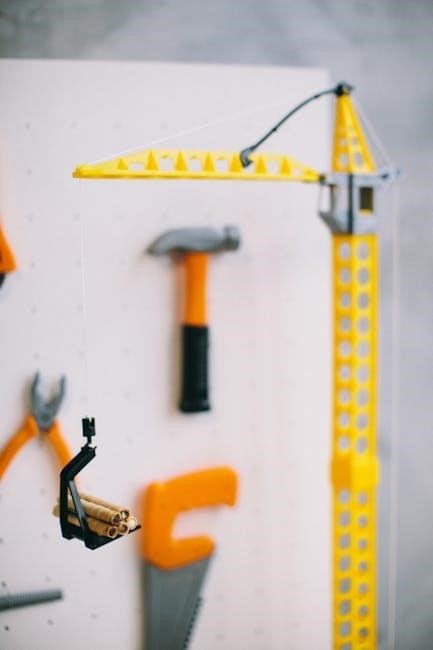Welcome to the Singer Model 301A Manual‚ your comprehensive guide to understanding and operating the Singer 301A sewing machine. This manual provides essential instructions for setup‚ maintenance‚ and troubleshooting‚ ensuring optimal performance and efficiency. Whether you’re a beginner or an experienced sewer‚ this guide will help you unlock the full potential of your Singer 301A‚ enabling you to create professional-quality stitches with ease and precision.
1.1 Overview of the Singer 301A Sewing Machine
The Singer Model 301A is a versatile and durable sewing machine designed for both home and professional use. Known for its slant needle mechanism‚ it offers superior visibility and precision stitching. The machine features a calibrated stitch regulator‚ allowing for easy control of stitch length‚ and stitching guides with graduated markings to ensure accurate seam widths. It also includes reverse stitching capability‚ enabling users to reinforce stitches effortlessly. With its robust construction and user-friendly design‚ the Singer 301A is ideal for a wide range of sewing tasks‚ from basic repairs to intricate projects. Its compact size and lightweight design make it easy to maneuver‚ while its advanced features cater to both beginners and experienced sewers. This machine is a reliable choice for anyone seeking a high-performance sewing experience.
1.2 Importance of the Manual for Users
The Singer Model 301A manual is an indispensable resource for users‚ providing detailed instructions to maximize the machine’s potential. It offers step-by-step guidance for setup‚ operation‚ and maintenance‚ ensuring users can troubleshoot common issues and maintain optimal performance. The manual includes exploded parts views and diagrams‚ making it easier to identify and replace components. For beginners‚ it serves as a comprehensive learning tool‚ while experienced users can rely on it for advanced techniques and customization. By following the manual’s instructions‚ users can extend the machine’s lifespan‚ prevent costly repairs‚ and achieve professional-quality results. Whether you’re sewing for personal projects or commercial purposes‚ the manual is your go-to guide for achieving the best outcomes with the Singer 301A;

1.3 Table of Contents
The Singer Model 301A manual is organized into a clear and detailed table of contents‚ ensuring easy navigation through its comprehensive guide. The manual is divided into seven main sections‚ each addressing specific aspects of the sewing machine. Section 1 introduces the manual and provides an overview of the Singer 301A. Section 2 highlights the machine’s key features‚ such as the slant needle mechanism and calibrated stitch regulator. Sections 3 and 4 cover setup‚ operation‚ and basic controls‚ while Section 5 focuses on maintenance and troubleshooting. Advanced techniques and customization options are explored in Section 6. Finally‚ Section 7 includes a parts diagram and information on accessories. This structured approach allows users to quickly locate specific information‚ making the manual an invaluable resource for both beginners and experienced sewers.

Key Features of the Singer Model 301A
The Singer Model 301A boasts a slant needle mechanism for improved visibility‚ a calibrated stitch regulator for precise control‚ stitching guides with markings‚ and reverse stitching capability for professional results.
2.1 Slant Needle Mechanism
The Singer Model 301A features an innovative slant needle mechanism‚ designed to enhance stitching accuracy and fabric control. This mechanism allows for better visibility of the stitching area‚ making it easier to guide fabrics smoothly under the needle. The slant needle also reduces fabric dragging‚ ensuring even stitching and preventing bunching or distortion‚ especially when working with delicate or layered materials. This feature is particularly beneficial for precision sewing‚ enabling users to achieve professional-quality results with minimal effort. The slant needle mechanism contributes to the machine’s robust performance and versatility‚ making it suitable for a wide range of sewing projects‚ from simple repairs to complex garment construction. By incorporating this advanced design‚ the Singer 301A delivers unparalleled ease of use and stitching consistency‚ catering to both novice and experienced sewers alike.
2.2 Calibrated Stitch Regulator
The Singer Model 301A is equipped with a calibrated stitch regulator‚ offering precise control over stitch length. This feature allows users to adjust stitches effortlessly‚ ensuring uniformity in every seam. The regulator is designed for fingertip control‚ making it easy to customize stitching based on fabric type and project requirements. Graduated markings on the regulator provide clear guidance‚ enabling accurate adjustments for consistent results. This feature is particularly useful for maintaining professional-quality stitching‚ whether sewing delicate fabrics or heavy-duty materials. The calibrated stitch regulator enhances the machine’s versatility‚ allowing users to achieve the perfect stitch length for various sewing tasks. By providing precise control‚ it ensures that every project meets high standards of quality and finish‚ making it an essential tool for both novice and experienced sewers.

2.3 Stitching Guides with Graduated Markings
The Singer Model 301A features stitching guides with graduated markings‚ designed to help users achieve precise and consistent seams. These guides provide clear visual indicators for seam width and alignment‚ making it easier to sew straight lines and accurate hems. The graduated markings allow for quick adjustments‚ ensuring that fabric edges are evenly aligned throughout the sewing process. This feature is particularly useful for beginners‚ as it simplifies the learning curve and helps build confidence in sewing techniques. The stitching guides also cater to experienced sewers‚ enabling them to work efficiently on intricate patterns and heavy-duty fabrics. By offering a reliable reference point‚ the graduated markings enhance the overall sewing experience‚ ensuring professional-quality results with every stitch. This feature underscores the Singer 301A’s commitment to precision and versatility‚ making it a valuable tool for a wide range of sewing projects.
2.4 Reverse Stitching Capability
The Singer Model 301A sewing machine features a convenient reverse stitching capability‚ allowing users to sew backward with ease. This function is essential for securing seams at the beginning or end of a stitching line‚ preventing unraveling and ensuring durability. Activating reverse stitch is straightforward‚ typically involving a simple lever or button adjustment. Reverse stitching is particularly useful for heavy-duty fabrics‚ thick seams‚ or delicate materials that require extra reinforcement; It also enhances control when working on intricate patterns or layered fabrics. By enabling precise backstitching‚ this feature adds professionalism to every project‚ from garment construction to home decor. The Singer 301A’s reverse stitching capability is a testament to its versatility‚ catering to both novice and experienced sewers by providing a reliable method to strengthen stitches and ensure long-lasting results.
Setup and Installation
Setting up the Singer Model 301A involves unpacking‚ placing the machine on a stable surface‚ and ensuring all parts are included; Proper installation ensures smooth operation and longevity.
3.1 Unboxing and Initial Setup
When you unbox your Singer Model 301A sewing machine‚ carefully inspect the contents to ensure all components are included. Remove the machine from its packaging and wipe it down with a soft cloth to remove any dust or debris. Place the machine on a stable‚ flat surface‚ such as a sewing table or countertop. Before powering it on‚ familiarize yourself with the machine’s exterior‚ including the stitch regulator‚ needle bar‚ and bobbin area. Refer to the exploded parts diagram in the manual for clarity. Attach any additional accessories‚ such as the sewing attachments‚ according to the instructions provided. Finally‚ conduct a quick test by running a scrap piece of fabric through the machine to ensure it is functioning properly. This initial setup ensures a smooth start to your sewing experience.
3.2 Oil and Lubrication Requirements
Proper lubrication is essential for the smooth operation of your Singer Model 301A sewing machine. Use high-quality sewing machine oil to lubricate moving parts‚ such as the needle bar‚ take-up lever‚ and bobbin case. Apply a few drops of oil to the specified areas‚ as indicated in the manual or parts diagram. Avoid using household oils‚ as they may leave residue and damage the machine. After lubrication‚ turn the handwheel gently to distribute the oil evenly throughout the mechanism. It is recommended to lubricate the machine every 50 hours of use or when you notice increased noise or friction. Regular lubrication ensures optimal performance‚ reduces wear on parts‚ and prolongs the machine’s lifespan. Always refer to the manual for specific instructions on where and how much oil to apply for best results.
3.3 Threading the Machine
Threading the Singer Model 301A sewing machine is a straightforward process that ensures smooth stitching. Begin by placing the spool of thread on the spool pin and securing it with the spool cap. Gently pull the thread through the tension discs‚ ensuring it is seated properly. Next‚ guide the thread around the take-up lever‚ moving from top to bottom. Loop the thread behind the needle bar and insert it through the needle’s eye from front to back. Pull the thread gently to remove any slack. Avoid twisting or pulling too tightly‚ as this may cause the thread to break or the tension to become uneven. Refer to the manual’s diagram for visual guidance. Proper threading ensures consistent stitch quality and prevents common issues like skipped stitches or thread breakage. Always use high-quality thread suitable for your fabric type to achieve the best results. Regularly check and re-thread as needed for optimal performance.
3.4 Bobbin Installation
Installing the bobbin in the Singer Model 301A sewing machine is a crucial step for proper stitching. Begin by ensuring the machine is turned off. Remove the bobbin case from the machine and carefully place the pre-wound bobbin into the case‚ making sure it is seated correctly. The bobbin should align with the markings on the case to ensure proper rotation. Replace the bobbin case into the machine‚ aligning it with the shaft and gently pushing it into place until it clicks. Pull a small amount of thread through the bobbin case to ensure it is properly engaged. Use only Singer-compatible bobbins to maintain consistent performance. Improper installation may result in uneven stitching or machine malfunction. Always refer to the manual’s diagram for accurate guidance and to avoid common mistakes. Proper bobbin installation ensures smooth thread delivery and high-quality stitching results.

Operating the Singer Model 301A
Operating the Singer Model 301A involves mastering basic controls and understanding stitch types. Utilize the stitch regulator for consistent stitching and reverse stitching for reinforced seams. Practice makes perfect.
4.1 Basic Operation and Controls
Mastering the basic operation and controls of the Singer Model 301A is essential for seamless sewing. Begin by familiarizing yourself with the power switch‚ located on the right side‚ which activates the machine. The stitch regulator‚ a key feature‚ allows precise control over stitch length‚ ensuring consistent results. Adjust the regulator by turning the dial to select your desired stitch length. The reverse stitching lever‚ positioned near the stitch regulator‚ enables sewing in reverse for reinforcing seams. Always ensure the machine is properly threaded and the bobbin is installed correctly before starting. Use the foot pedal to control sewing speed‚ maintaining gentle pressure for consistent stitching. For safety‚ never leave the machine unattended while it is operational. By understanding these fundamental controls‚ you can achieve professional-quality stitching with ease and precision.
4.2 Understanding Stitch Types
The Singer Model 301A offers a variety of stitch types to cater to different sewing needs. The machine features a straight stitch‚ ideal for general sewing‚ and a reverse stitch option for reinforcing seams. To select the desired stitch‚ use the stitch regulator‚ which provides precise control over stitch length. Adjust the regulator by turning the dial to achieve the perfect stitch length for your fabric type. For delicate fabrics‚ a shorter stitch length is recommended‚ while thicker materials may require longer stitches. Ensure the machine is properly threaded and the bobbin is correctly installed before sewing. Always test the stitch type and length on a scrap piece of fabric to ensure the desired result. By understanding and utilizing the various stitch options‚ you can achieve professional-quality results for any sewing project. This feature enhances versatility‚ making the Singer 301A suitable for both beginners and experienced sewers.
4.3 Using the Stitch Regulator
The Singer Model 301A features a calibrated stitch regulator‚ allowing for precise control over stitch length. To use the stitch regulator‚ locate the dial on the front of the machine. Turn the dial clockwise or counterclockwise to adjust the stitch length according to your fabric type and sewing needs. The regulator enables finger-tip control‚ making it easy to achieve consistent stitches. For delicate fabrics‚ a shorter stitch length is recommended‚ while thicker materials may require longer stitches. Always test the stitch length on a scrap piece of fabric before sewing your final project. This feature ensures professional-quality results and enhances your sewing experience. By mastering the stitch regulator‚ you can customize your sewing projects with precision and ease‚ making the Singer 301A a versatile tool for any sewer.
4.4 Sewing in Reverse
To sew in reverse on the Singer Model 301A‚ locate the reverse stitch lever or button‚ typically found on the front or side of the machine. Engage the reverse feature before starting your seam to secure the beginning of your stitching; Once activated‚ the machine will sew backward‚ allowing you to reinforce seams or prevent fraying. This is particularly useful for heavy fabrics or when sewing in challenging areas. When you’re ready to switch back to forward stitching‚ disengage the reverse feature and continue sewing normally. Always ensure the fabric is properly aligned and guided during reverse stitching to maintain evenness. Regular use of the reverse stitch function can enhance the durability and professionalism of your sewing projects. This feature is a valuable tool for both beginners and experienced sewers‚ ensuring strong and secure seams every time.

Maintenance and Troubleshooting
Regular maintenance and troubleshooting are essential for ensuring the Singer Model 301A operates smoothly. This section provides tips for cleaning‚ oiling‚ and resolving common issues to keep your machine in optimal condition.

5.1 Routine Maintenance Tips
To ensure the Singer Model 301A operates smoothly‚ regular maintenance is essential. Start by lubricating the machine according to the recommended schedule‚ using only Singer-approved oil to prevent damage. Clean the bobbin area and tension discs frequently to remove lint and thread debris. Check the needle regularly and replace it if it shows signs of wear or damage. Use a soft brush to dust internal components‚ ensuring proper mechanical function. Inspect the stitch regulator and guides for alignment and cleanliness. Store the machine in a dry‚ cool place to avoid rust or moisture issues. Finally‚ refer to the manual for specific maintenance intervals and follow the troubleshooting guide for any unusual noises or performance changes. Regular upkeep will extend the life of your Singer 301A and maintain its stitching precision.
5.2 Common Issues and Solutions
The Singer Model 301A‚ like any sewing machine‚ may encounter occasional issues. One common problem is poor stitch quality‚ often caused by incorrect tension settings or a dull needle. To resolve this‚ adjust the tension discs and replace the needle if necessary. Another issue is thread bunching‚ which can be addressed by ensuring proper threading and using high-quality thread. If the machine fails to power on‚ check the power cord and ensure it is securely plugged in. For jammed fabric‚ gently remove the material and clean any debris from the machine. Needle breakage can occur if the needle is incorrectly inserted or if heavy fabric is used; always install the needle correctly and choose the right needle type for your fabric. Regular maintenance‚ as outlined in the manual‚ can prevent many of these issues and ensure smooth operation. Addressing problems promptly will extend the machine’s lifespan and maintain its performance.
5.3 Adjusting and Replacing Parts
Adjusting and replacing parts on the Singer Model 301A is essential for maintaining its performance and extending its lifespan. Regularly inspect the stitch regulator‚ tension discs‚ and bobbin case for proper alignment and cleanliness. If the stitch length or width is inconsistent‚ refer to the manual for calibration instructions. The needle bar and take-up lever may require occasional adjustment to ensure smooth stitching. For parts replacement‚ use only genuine Singer 301A components to guarantee compatibility and quality. The exploded parts diagram in the manual provides a clear visual guide for identifying and replacing parts. Always turn off and unplug the machine before performing any adjustments or replacements. Lubricate moving parts as specified to prevent friction and wear. Proper adjustment and timely replacement of worn or damaged parts will keep your Singer 301A sewing machine operating efficiently and reliably.
5.4 Troubleshooting Guide
The Singer Model 301A Manual includes a detailed troubleshooting guide to help users identify and resolve common issues. If the machine fails to stitch properly‚ check the needle for damage or incorrect installation. Ensure the thread is correctly threaded through the tension discs and take-up lever. If fabric is not feeding smoothly‚ inspect the presser foot for proper alignment and cleanliness. For inconsistent stitch length‚ verify the stitch regulator is calibrated correctly. If the machine makes unusual noises‚ check for loose screws or debris in the internal mechanisms. Refer to the manual’s exploded parts diagram to locate and inspect components. Lubricate moving parts periodically to prevent friction. For persistent issues‚ consult the troubleshooting section or contact Singer support for assistance. Regular maintenance and proper care will ensure your Singer 301A operates efficiently and reliably over time.

Advanced Features and Techniques
Discover advanced features of the Singer 301A‚ including custom stitching patterns‚ specialized attachments‚ and performance optimization tips. Enhance your sewing skills with these sophisticated techniques for professional results;
6.1 Custom Stitching Patterns
The Singer Model 301A allows users to explore their creativity with custom stitching patterns. By adjusting the calibrated stitch regulator and utilizing the stitching guides with graduated markings‚ you can create unique and precise stitch designs. This feature is particularly useful for embroidering‚ quilting‚ or adding decorative elements to your projects. The machine’s slant needle mechanism ensures smooth fabric movement‚ making it easier to achieve intricate patterns. Experiment with different stitch lengths and widths to develop personalized designs tailored to your sewing needs. Whether you’re crafting home decor or fashion items‚ the Singer 301A empowers you to bring your creative vision to life with professional-grade results.
6.2 Using Sewing Attachments
The Singer Model 301A supports a variety of sewing attachments designed to enhance your sewing experience. These accessories allow you to tackle specific tasks with precision‚ such as zipper insertion‚ buttonholes‚ and edge trimming. To use an attachment‚ ensure it is compatible with your machine by consulting the parts diagram or manual. Attachments typically snap or screw onto the machine’s presser foot area. Once installed‚ follow the manufacturer’s instructions for adjusting settings like stitch length or tension. Always test the attachment on scrap fabric before working on your final project. Proper use of attachments can significantly expand the machine’s capabilities‚ enabling you to create professional-quality finishes and intricate designs with ease. Refer to the Singer 301A manual for detailed guidance on compatible attachments and their installation.
6.3 Optimizing Machine Performance
Optimizing the performance of your Singer Model 301A involves regular maintenance‚ proper usage‚ and adherence to best practices. Ensure the machine is clean and free from dust or debris‚ as buildup can hinder operation. Lubricate moving parts periodically to maintain smooth functionality. Always use high-quality thread and needles suitable for your fabric type to prevent breakage or uneven stitching. Properly tension the thread and bobbin to achieve consistent stitches. Regularly check and replace worn-out parts‚ such as the needle or bobbin case‚ to avoid performance issues. Additionally‚ use the correct presser foot for your project to ensure even fabric feeding. By following these steps‚ you can enhance the machine’s efficiency and extend its lifespan. Refer to the manual for specific maintenance schedules and troubleshooting tips to keep your Singer 301A performing at its best.

Parts Diagram and Accessories
Explore the Singer Model 301A Parts Diagram to identify components and order replacements. Compatible accessories include presser feet‚ bobbins‚ and needles. Ensure authenticity by purchasing from trusted suppliers.
7.1 Understanding the Parts Diagram

The Singer Model 301A manual includes a detailed parts diagram‚ essential for identifying and understanding the various components of your sewing machine. This visual guide provides a clear overview of the machine’s structure‚ highlighting key parts such as the needle bar‚ bobbin case‚ stitch regulator‚ and tension dials. The diagram is particularly useful for maintenance‚ troubleshooting‚ and replacing parts. By referencing the parts diagram‚ users can locate specific components quickly‚ ensuring accurate adjustments and repairs. It also serves as a handy tool for ordering replacement parts‚ as it provides precise identifiers for each item. Familiarizing yourself with the parts diagram will enhance your ability to care for and optimize your Singer 301A‚ making it an indispensable resource for both beginners and experienced sewers.
7.2 Compatible Accessories
The Singer Model 301A manual highlights a variety of compatible accessories designed to enhance your sewing experience. These include presser feet for specialized tasks‚ such as zipper‚ buttonhole‚ and blind hemming‚ as well as additional bobbins and needles tailored for different fabric types. The manual also lists optional attachments like edge joiners‚ rufflers‚ and quilting guides‚ which expand the machine’s functionality. Accessories are carefully designed to fit the Singer 301A’s unique slant needle mechanism‚ ensuring seamless integration. For convenience‚ the manual provides part numbers and descriptions‚ making it easy to identify and purchase genuine Singer accessories. These tools allow users to explore advanced techniques‚ handle diverse projects‚ and maintain their machine in optimal condition. By utilizing compatible accessories‚ sewers can unlock the full potential of their Singer 301A‚ achieving professional-quality results across various sewing applications.
7.3 Ordering Replacement Parts
The Singer Model 301A manual provides detailed guidance on ordering replacement parts‚ ensuring users can maintain their machine’s performance. The manual includes a parts diagram with specific part numbers‚ making it easy to identify and purchase genuine Singer components. Users can find replacement parts through Singer-authorized dealers or online marketplaces like eBay and Etsy. The manual emphasizes the importance of using original Singer parts to ensure compatibility and maintain the machine’s functionality. Instructions are provided on how to request parts‚ including model number verification and packaging details. This section is essential for extending the life of the Singer 301A and keeping it in optimal working condition. By following the manual’s guidelines‚ users can efficiently obtain the necessary parts to repair or upgrade their sewing machine.